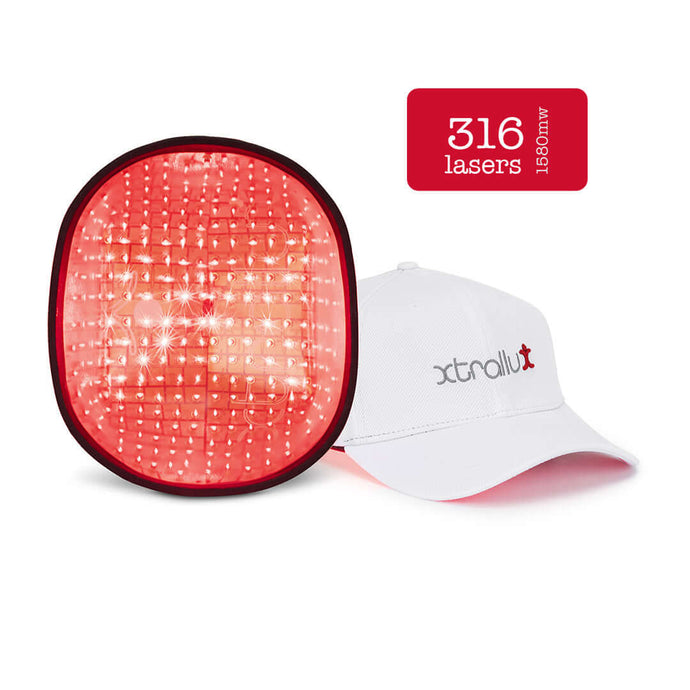Hair Loss in Men
Men typically experience a receding hairline and a gradual thinning on the crown. This is often due to male pattern baldness, which is linked to genetics and hormones.

If you’re dealing with mild to moderate hair loss or worried about future hair loss, Xtrallux is your answer. Find out if Xtrallux is the right fit for you by taking our personalized quiz.

Men typically experience a receding hairline and a gradual thinning on the crown. This is often due to male pattern baldness, which is linked to genetics and hormones.

Women, on the other hand, may experience a more diffuse pattern of hair loss, with thinning happening all over the scalp. This can be caused by hormonal changes, stress, certain medications, and even hairstyles that put a lot of tension on the hair.

Hereditary hair loss, also known as androgenetic alopecia, is the most common cause of hair loss in both men and women. This type of hair loss is linked to an inherited sensitivity to dihydrotestosterone (DHT), a byproduct of testosterone that causes hair follicles to shrink and ultimately stop growing new hair.

Emotional and physical stress can contribute to excessive hair shedding. When the body is under stress, it diverts resources away from non-essential functions like hair growth, leading to a temporary increase in hair loss.

Fluctuations in hormones can disrupt the hair growth cycle. Conditions like pregnancy, menopause, thyroid disorders, and polycystic ovary syndrome (PCOS) can all contribute to hormonal imbalances that lead to hair loss.

A lack of essential nutrients can impair hair growth. Deficiencies in vitamins like biotin, iron, zinc, and protein can weaken hair follicles and lead to excessive shedding.

Certain conditions can cause hair loss as a side effect. Autoimmune diseases, cancer treatments, and skin conditions like alopecia areata can all trigger hair loss.

Harsh hairstyling techniques can damage hair follicles. Tight hairstyles, chemical treatments, and excessive heat styling can lead to traction alopecia and breakage, contributing to thinning hair.
When it comes to addressing hair loss, the journey is not just about finding an effective solution, but also about managing the costs associated with various treatments. From wigs and extensions to supplements and surgical options, the financial investment in hair restoration can be significant.





Low-Level Laser Therapy (LLLT) operates under the principle of photo-biomodulation.
Low-Level Laser Therapy (LLLT) utilizes specific wavelengths of light to stimulate hair follicles. This light energy enhances cellular activity in the scalp, promoting hair growth. Xtrallux targets weakened follicles, increasing blood circulation and nutrient flow, which strengthens hair, reduces hair loss, and encourages new growth. In just 6 minutes a day, Xtrallux harnesses FDA-cleared, clinically-proven technology to nurture the growth of new, healthier hair.
Historically, Low-Level Laser Therapy (LLLT) was a luxury confined to the doctor's offices, involving bulky, expensive equipment and requiring frequent visits, making it an inconvenient and costly option for many. However, the landscape of hair restoration has dramatically changed. LLLT is now accessible to everyone, right in the comfort of their own homes.

Don't let another day go by without addressing your hair loss concerns.
Xtrallux is not just a product, it's a commitment to ongoing hair health, recommended for its lasting benefits.
Is Xtrallux Right for You?
If you’re dealing with mild to moderate hair loss or worried about future hair loss, Xtrallux is your answer. This FDA-cleared laser therapy is drug-free and hassle-free, offering a proven alternative to surgical procedures. Find out if Xtrallux is the right fit for you by taking our personalized quiz.
Xtrallux Hair Regrowth caps are recommended for adults (men or women) who are experiencing mild to moderate hair loss due to androgenic alopecia with Fitzpatrick Skin Types I to IV as per indications for use. If your hair loss is advanced or due to scarring alopecias, this device is not right for you. Please consult with your healthcare provider for other types of hair loss (ie. medically-induced, areata, universalis, or totalis alopecias, effluvium, etc) and skin types.
Xtrallux is indicated for mild to moderate hair loss cases. If you're hair loss is advanced, you are not a candidate for laser therapy. Please read the indications for use on the product pages for detail.
Laser therapy at 650 nm and <5mW has never had any reported adverse effects for ANY skin tone, including the darkest of skin tones but due to limitations in testing protocols has only been clinically tested for treatment of AGA on skin types 1-4. Xtrallux devices are not cleared for dark skin tones due to the substantial equivalence process of FDA clearances.
Yes. The United States Food & Drug Administration has cleared Xtrallux hair regrowth devices as effective for treating androgenetic alopecia (see full indication for use). The clearance is based on substantiation by earlier submissions to the FDA providing clinical data to verify that this type of medical device emitting red laser energy results in an increase in terminal hair counts over the course of time with continued use. Terminal hair is defined as long, coarse, well-pigmented hair which differs from vellus hair.
Xtrallux manufactures devices use this technology which has been proven to increase counts of terminal hair in clinical trials accepted as substantiation by the FDA for prior clearances for this device classification.
Keep in mind that results will vary from person to person. Each case is different.
Your cart is currently empty.
Start Shopping
